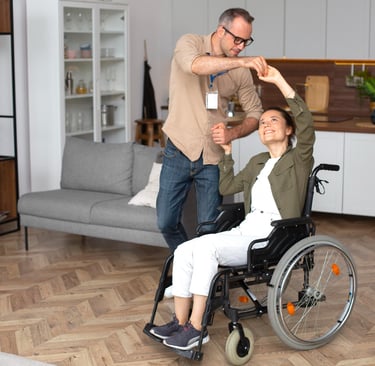How to address home healthcare problems for paralyzed patients?
Caring for Paralysis at Home: Challenges and Solutions


Living with paralysis brings unique daily challenges that can impact quality of life. While hospitals focus on initial treatment and rehabilitation, continuing care at home often falls on family members who may not be medically trained. This can lead to health issues if problems are not addressed properly. Here are some common concerns paralyzed patients face at home and potential solutions to make home healthcare management easier.
Mobility & Transfer Issues
Limited mobility is one of the biggest difficulties. Patients may need help moving from bed to wheelchair to bathroom. Manual lifting can hurt caregivers' backs over time.
Solutions include investing in a ceiling lift, portable lift or transfer boards. These mechanical aids make transfers safer for both patient and caregiver. Rails or grab bars in key areas provide stability support during movements. Well-padded wheelchairs prevent sores.
Bathroom Accessibility
Standard toilets and showers pose challenges. Patients may require assistance with bathing, changing clothes and using the toilet.
Modifying bathrooms with walk-in showers, adjustable shower seats, toilet risers and grab bars allows independent access. For those with upper body mobility, installing a shower chair or transfer bench is helpful.
Pressure Sore Prevention
Patients who cannot feel or move certain body parts are at high risk of pressure sores from prolonged sitting or lying down. These sores can become severely infected if not addressed.
Caregivers must perform regular skin checks and change seated positions every 30 minutes. Special cushions, mattresses and pillows that reduce pressure help circulation. Keeping skin clean and dry also prevents breakdown. Consult a doctor or nurse if any redness appears.
Bowel & Bladder Care
Paralysis may impact bladder and bowel control or sensation. Patients may require catheterization, laxatives or manual evacuation assistance.
Timely toileting schedules, pelvic floor exercises, healthy diet, adequate hydration and digital stimulation can help regulate functions naturally over time with practice. Portable commodes also provide convenient access.
Respiratory Issues
Paralysis affecting chest muscles can cause respiratory problems. Patients are prone to pneumonia from fluid accumulation.
Postural drainage techniques help clear congestion. Cough assist machines make coughing more effective. A portable suction machine quickly removes secretions. Oxygen therapy may be required in severe cases.
Nutrition & Hydration
Eating and drinking independently can become difficult without hand or arm function. Dehydration or unbalanced diets impact health and healing.
Adapted utensils, non-spill cups, plate guards and liquid thickeners enable self-feeding. A feeding tube may be considered if oral intake is inadequate. Caregivers must ensure proper hydration and a nutritious diet is maintained.
Mental Health Support
Adjusting to a disability is psychologically challenging. Patients may feel depressed, anxious or socially isolated. Caregivers are also at risk of burnout.
Counseling helps process emotions in a healthy way. Support groups offer community and advice from others in similar situations. Ensuring social interaction and engaging in hobbies or activities provides mental stimulation too.
Technological Advances
New assistive devices are continuously improving home care access. Some examples include powered wheelchairs, exoskeletons for walking assistance, communication aids and smart home automation.
Virtual reality systems provide immersive rehabilitation experiences too. Artificial intelligence and robotics show promise to enhance independence through intelligent home monitoring and assistance.
The home environment should be adapted based on individual needs. A caring support system and problem-solving approach can help paralyzed patients live fulfilling lives despite physical limitations. With the right solutions in place, home healthcare management is very achievable.
